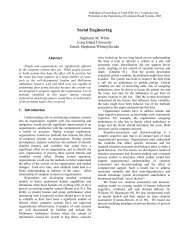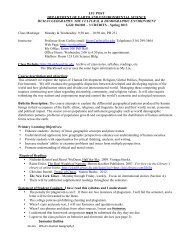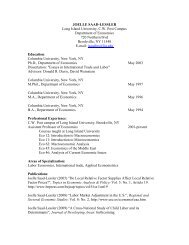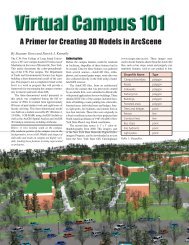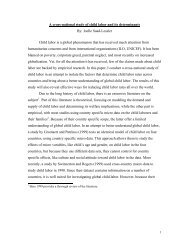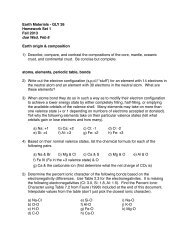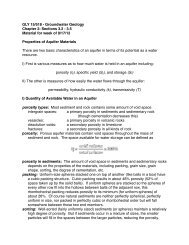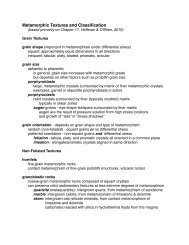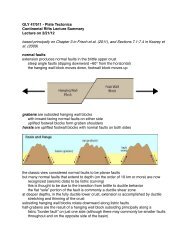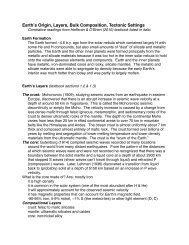Attention! Your ePaper is waiting for publication!
By publishing your document, the content will be optimally indexed by Google via AI and sorted into the right category for over 500 million ePaper readers on YUMPU.
This will ensure high visibility and many readers!

Your ePaper is now published and live on YUMPU!
You can find your publication here:
Share your interactive ePaper on all platforms and on your website with our embed function

Enterprise COBOL for z/OS V4.2 Programming Guide
Enterprise COBOL for z/OS V4.2 Programming Guide
Enterprise COBOL for z/OS V4.2 Programming Guide
- No tags were found...
Create successful ePaper yourself
Turn your PDF publications into a flip-book with our unique Google optimized e-Paper software.
"A" Also "a""B" Also "b""C" Also "c""D" Also "d""E" Also "e""F" Also "f""G" Also "g""H" Also "h""I" Also "i""J" Also "j""K" Also "k""L" Also "l""M" Also "m""N" Also "n""O" Also "o""P" Also "p""Q" Also "q""R" Also "r""S" Also "s""T" Also "t""U" Also "u""V" Also "v""W" Also "w""X" Also "x""Y" Also "y""Z" Also "z".RELATED TASKS“Specifying the collating sequence” on page 9Defining symbolic charactersUse the SYMBOLIC CHARACTERS clause to give symbolic names to any character of thespecified alphabet. Use ordinal position to identify the character, where position 1corresponds to character X’00’.For example, to give a name to the backspace character (X’16’ in the EBCDICalphabet), code:SYMBOLIC CHARACTERS BACKSPACE IS 23Defining a user-defined classUse the CLASS clause to give a name to a set of characters that you list in theclause.For example, name the set of digits by coding the following clause:CLASS DIGIT IS "0" THROUGH "9"You can reference the class-name only in a class condition. (This user-defined classis not the same as an object-oriented class.)Defining files to the operating systemFor all files that you process in your <strong>COBOL</strong> program, you need to define the filesto the operating system with an appropriate system data definition.Depending on the operating system, this system data definition can take any of thefollowing <strong>for</strong>ms:v DD statement <strong>for</strong> MVS JCL.10 <strong>Enterprise</strong> <strong>COBOL</strong> <strong>for</strong> z/<strong>OS</strong> <strong>V4.2</strong> <strong>Programming</strong> <strong>Guide</strong>
"A" Also "a""B" Also "b""C" Also "c""D" Also "d""E" Also "e""F" Also "f""G" Also "g""H" Also "h""I" Also "i""J" Also "j""K" Also "k""L" Also "l""M" Also "m""N" Also "n""O" Also "o""P" Also "p""Q" Also "q""R" Also "r""S" Also "s""T" Also "t""U" Also "u""V" Also "v""W" Also "w""X" Also "x""Y" Also "y""Z" Also "z".RELATED TASKS“Specifying the collating sequence” on page 9Defining symbolic charactersUse the SYMBOLIC CHARACTERS clause to give symbolic names to any character of thespecified alphabet. Use ordinal position to identify the character, where position 1corresponds to character X’00’.For example, to give a name to the backspace character (X’16’ in the EBCDICalphabet), code:SYMBOLIC CHARACTERS BACKSPACE IS 23Defining a user-defined classUse the CLASS clause to give a name to a set of characters that you list in theclause.For example, name the set of digits by coding the following clause:CLASS DIGIT IS "0" THROUGH "9"You can reference the class-name only in a class condition. (This user-defined classis not the same as an object-oriented class.)Defining files to the operating systemFor all files that you process in your <strong>COBOL</strong> program, you need to define the filesto the operating system with an appropriate system data definition.Depending on the operating system, this system data definition can take any of thefollowing <strong>for</strong>ms:v DD statement <strong>for</strong> MVS JCL.10 <strong>Enterprise</strong> <strong>COBOL</strong> <strong>for</strong> z/<strong>OS</strong> <strong>V4.2</strong> <strong>Programming</strong> <strong>Guide</strong>
v ALLOCATE command under TSO.v Environment variable <strong>for</strong> z/<strong>OS</strong> or UNIX. The contents can define either an MVSdata set or a file in the HFS (hierarchical file system).The following examples show the relationship of a FILE-CONTROL entry to thesystem data definition and to the FD entry in the FILE SECTION:v JCL DD statement:vv(1)//OUTFILE DD DSNAME=MY.OUT171,UNIT=SYSDA,SPACE=(TRK,(50,5))/*Environment variable (export command):(1)export OUTFILE=DSN(MY.OUT171),UNIT(SYSDA),SPACE(TRK,(50,5))<strong>COBOL</strong> code:ENVIRONMENT DIVISION.INPUT-OUTPUT SECTION.FILE-CONTROL.SELECT CARPOOLASSIGN TO OUTFILE (1)ORGANIZATION IS SEQUENTIAL....DATA DIVISION.FILE SECTION.FD CARPOOL (2)LABEL RECORD STANDARDBLOCK CONTAINS 0 CHARACTERSRECORD CONTAINS 80 CHARACTERS(1) The assignment-name in the ASSIGN clause points to the ddname OUTFILE inthe DD statement or the environment variable OUTFILE in the exportcommand:v //OUTFILE DD DSNAME=OUT171 ...,orv export OUTFILE= ...(2) When you specify a file file-name in a FILE-CONTROL entry, you mustdescribe the file in an FD entry:SELECT CARPOOL...FD CARPOOLRELATED TASKS“Optimizing buffer and device space” on page 12RELATED REFERENCES“FILE SECTION entries” on page 14File section (<strong>Enterprise</strong> <strong>COBOL</strong> Language Reference)Varying the input or output file at run timeThe file-name that you code in a SELECT clause is used as a constant throughoutyour <strong>COBOL</strong> program, but you can associate the name of the file with a differentactual file at run time.Changing a file-name in a <strong>COBOL</strong> program would require changing the inputstatements and output statements and recompiling the program. Alternatively, youcan change the DSNAME value in the DD statement or the DSN or PATH value in theexport command to use a different file at run time.Chapter 1. Structuring your program 11
- Page 1: Enterprise COBOL for z/OSProgrammin
- Page 4: Note!Before using this information
- Page 7 and 8: Chapter 9. Processing QSAM files .
- Page 9 and 10: LINECOUNT . . . . . . . . . . . . .
- Page 11 and 12: ||Handling encoding conflicts . . .
- Page 13 and 14: |||||XML PARSE exceptions withXMLPA
- Page 15 and 16: Tables1. FILE-CONTROL entries . . .
- Page 17 and 18: PrefaceAbout this informationWelcom
- Page 19 and 20: vThe ---> symbol indicates that the
- Page 21 and 22: Summary of changesThis section list
- Page 23 and 24: How to send your commentsYour feedb
- Page 25 and 26: Part 1. Coding your programChapter
- Page 27 and 28: Comparing national data andalphanum
- Page 29 and 30: Chapter 1. Structuring your program
- Page 31 and 32: RELATED CONCEPTS“Nested programs
- Page 33: Specifying the collating sequenceYo
- Page 37 and 38: The AWO compiler option applies an
- Page 39 and 40: Table 2. FILE SECTION entries (cont
- Page 41 and 42: RELATED TASKS“Ending and reenteri
- Page 43 and 44: A nested program can also access da
- Page 45 and 46: “Scope terminators” on page 22
- Page 47 and 48: IF ITEM = "A"DISPLAY "THE VALUE OF
- Page 49 and 50: Chapter 2. Using dataThis informati
- Page 51 and 52: the DATA DIVISION as shown below. N
- Page 53 and 54: For example:Move Spaces To Report-H
- Page 55 and 56: ALPHABETIC-1 ANJUST before ANJUST a
- Page 57 and 58: identical in each record that is pr
- Page 59 and 60: RELATED TASKS“Assigning values to
- Page 61 and 62: RELATED REFERENCES“DIAGTRUNC” o
- Page 63 and 64: Displaying data on the system logic
- Page 65 and 66: ...Compute Sqrt = 16 ** .5Compute z
- Page 67 and 68: Table 4. Effect of RMODE and RENT c
- Page 69 and 70: Chapter 3. Working with numbers and
- Page 71 and 72: Displaying numeric dataYou can defi
- Page 73 and 74: vInternal floating point (USAGE COM
- Page 75 and 76: A binary number with a PICTURE desc
- Page 77 and 78: Table 6. Internal representation of
- Page 79 and 80: When a USAGE COMP-2 data item is mo
- Page 81 and 82: The numeric class test checks the c
- Page 83 and 84: Arithmetic expressions can consist
- Page 85 and 86:
ARITH(EXTEND), COBOL floating-point
- Page 87 and 88:
General number handlingSuppose you
- Page 89 and 90:
Many statements in a program could
- Page 91 and 92:
Using currency signsadd report-matr
- Page 93 and 94:
Chapter 4. Handling tablesA table i
- Page 95 and 96:
Nesting tablesTo create a two-dimen
- Page 97 and 98:
vSubscriptingvvUse the data-name of
- Page 99 and 100:
Initialize the index-name by using
- Page 101 and 102:
“Examples: initializing data item
- Page 103 and 104:
RELATED TASKS“Assigning values to
- Page 105 and 106:
Creating variable-length tables (DE
- Page 107 and 108:
01 LOCATION-RECORD.05 LOC-CODE PIC
- Page 109 and 110:
Each dimension of the table has its
- Page 111 and 112:
eference all the items in the table
- Page 113 and 114:
Chapter 5. Selecting and repeating
- Page 115 and 116:
RELATED TASKS“Coding a choice of
- Page 117 and 118:
The following example shows that yo
- Page 119 and 120:
Class condition (Enterprise COBOL L
- Page 121 and 122:
01 Switches05 Transaction-EOF-Switc
- Page 123 and 124:
ElsePerform 400-Print-Transaction-E
- Page 125 and 126:
Chapter 6. Handling stringsCOBOL pr
- Page 127 and 128:
Because the POINTER field LINE-POS
- Page 129 and 130:
01 WORK-REC.05 M-UNITS PIC 9(6).05
- Page 131 and 132:
vvUse a SEARCH statement to locate
- Page 133 and 134:
If the leftmost character position
- Page 135 and 136:
Tallying and replacing data items (
- Page 137 and 138:
RELATED TASKS“Converting to upper
- Page 139 and 140:
RELATED REFERENCES“Conversions an
- Page 141 and 142:
“Processing table items using int
- Page 143 and 144:
RELATED TASKS“Performing arithmet
- Page 145 and 146:
Chapter 7. Processing data in an in
- Page 147 and 148:
Table 15. COBOL statements and nati
- Page 149 and 150:
Table 16. Intrinsic functions and n
- Page 151 and 152:
Defining national data itemsDefine
- Page 153 and 154:
The IF statement above evaluates as
- Page 155 and 156:
01 Nat-Group-1 GROUP-USAGE NATIONAL
- Page 157 and 158:
Table 17. National group items that
- Page 159 and 160:
You can likewise move the following
- Page 161 and 162:
Example: converting to and from nat
- Page 163 and 164:
RELATED REFERENCES“Storage of cha
- Page 165 and 166:
These operands are treated as if th
- Page 167 and 168:
An alphanumeric literal that contai
- Page 169 and 170:
Chapter 8. Processing filesReading
- Page 171 and 172:
vvIndexed (VSAM)Relative (VSAM)RELA
- Page 173 and 174:
two-character category alphanumeric
- Page 175 and 176:
Chapter 9. Processing QSAM filesQue
- Page 177 and 178:
In this information, QSAM logical r
- Page 179 and 180:
example, when you specify a MOVE st
- Page 181 and 182:
vYou have greater flexibility when
- Page 183 and 184:
vIf you omit the RECORD clause, the
- Page 185 and 186:
vOPEN I-OUsing a block size that ex
- Page 187 and 188:
Use the REVERSED option of the OPEN
- Page 189 and 190:
Specify the number of lines the pag
- Page 191 and 192:
Restriction: You cannot create a PD
- Page 193 and 194:
((Parameters for creating QSAM file
- Page 195 and 196:
RELATED TASKS“Processing existing
- Page 197 and 198:
A striped extended-format QSAM data
- Page 199 and 200:
There are two kinds of labels: stan
- Page 201 and 202:
Standard user labelsUser labels are
- Page 203 and 204:
Chapter 10. Processing VSAM filesVi
- Page 205 and 206:
The following table compares the ch
- Page 207 and 208:
numeric-edited, national decimal, o
- Page 209 and 210:
RELATED TASKS“Defining VSAM files
- Page 211 and 212:
Table 28. Definition of VSAM variab
- Page 213 and 214:
RELATED CONCEPTS“File position in
- Page 215 and 216:
In addition to extra overhead for p
- Page 217 and 218:
RELATED TASKS“Specifying access m
- Page 219 and 220:
Handling errors in VSAM filesIf you
- Page 221 and 222:
PASSWORD IS BASE-PASSALTERNATE RECO
- Page 223 and 224:
and the prime index). After you def
- Page 225 and 226:
In either case, dsname must be the
- Page 227 and 228:
Restrictions when using RLSWhen you
- Page 229 and 230:
Table 33. Methods for improving VSA
- Page 231 and 232:
Chapter 11. Processing line-sequent
- Page 233 and 234:
FILE SECTION.FDCOMMUTER-FILERECORD
- Page 235 and 236:
Characters in the file record are r
- Page 237 and 238:
Chapter 12. Sorting and merging fil
- Page 239 and 240:
2. Describe the sort file in an SD
- Page 241 and 242:
To transfer records to the sort pro
- Page 243 and 244:
PROCEDURE DIVISION.A-CONTROL SECTIO
- Page 245 and 246:
SORT Sort-Work-1ON ASCENDING KEY So
- Page 247 and 248:
10 WS-EXT-EMPLOYEE-NUM PIC X(6).10
- Page 249 and 250:
If you do not reference SORT-RETURN
- Page 251 and 252:
QSAM requirementsv QSAM files must
- Page 253 and 254:
Table 35. Methods for controlling s
- Page 255 and 256:
Allocating space for sort filesIf y
- Page 257 and 258:
Chapter 13. Handling errorsPut code
- Page 259 and 260:
vvvZero raised to the zero powerZer
- Page 261 and 262:
Set status key(if present)Applicabl
- Page 263 and 264:
the execution of the statements wit
- Page 265 and 266:
Using VSAM status codes (VSAM files
- Page 267 and 268:
OPEN INPUT VSAMFILE FS-CODE: 00STAR
- Page 269 and 270:
PROCEDURE-POINTER data items enable
- Page 271 and 272:
Part 2. Compiling and debugging you
- Page 273 and 274:
Chapter 14. Compiling under z/OSYou
- Page 275 and 276:
Additional details about invoking c
- Page 277 and 278:
IGYWCL PROC LNGPRFX='IGY.V4R2M0',SY
- Page 279 and 280:
*//* PARAMETER DEFAULT VALUE USAGE/
- Page 281 and 282:
*//* COMPILE, PRELINK, LINK EDIT, A
- Page 283 and 284:
*//* COMPILE, PRELINK, LOAD, AND RU
- Page 285 and 286:
Compiling under TSO//JOB1 JOB (1)//
- Page 287 and 288:
ALLOC F(SYSUT5) NEW SPACE(5,5) TRAC
- Page 289 and 290:
“Defining an associated-data file
- Page 291 and 292:
The following table shows the defin
- Page 293 and 294:
Defining the output data set (SYSPR
- Page 295 and 296:
RELATED TASKSLanguage Environment C
- Page 297 and 298:
You can use more than one PROCESS s
- Page 299 and 300:
To create separate load modules, pr
- Page 301 and 302:
If you specify the LIB option for t
- Page 303 and 304:
Correcting errors in your source pr
- Page 305 and 306:
message-textThe message text; for a
- Page 307 and 308:
Chapter 15. Compiling under z/OS UN
- Page 309 and 310:
2. The values of BUFSIZE, LIB, SQL,
- Page 311 and 312:
Example: using cob2 to compile and
- Page 313 and 314:
cob2 input and output filesYou can
- Page 315 and 316:
Chapter 16. Compiling, linking, and
- Page 317 and 318:
After you issue the cob2 and javac
- Page 319 and 320:
Running OO applications that start
- Page 321 and 322:
|||In limited circumstances, howeve
- Page 323 and 324:
|//SYSPRINT DD SYSOUT=*//SYSTERM DD
- Page 325 and 326:
Chapter 17. Compiler optionsYou can
- Page 327 and 328:
system administrator.) To determine
- Page 329 and 330:
“Specifying compiler options in a
- Page 331 and 332:
v The maximum number of digits in t
- Page 333 and 334:
|BUFSIZEUse BUFSIZE to allocate an
- Page 335 and 336:
ccsid must be an integer that repre
- Page 337 and 338:
COMPILEUse the COMPILE option only
- Page 339 and 340:
Abbreviations are: NoneFor reentran
- Page 341 and 342:
DBCSUsing DBCS causes the compiler
- Page 343 and 344:
DLL option syntax►►NODLLDLL►
- Page 345 and 346:
vCOBOL programs that have EXEC SQL
- Page 347 and 348:
Error messages in the source listin
- Page 349 and 350:
LINE.COL CODEIGYDS8211FIPS MESSAGE
- Page 351 and 352:
LIBIf your program uses COPY, BASIS
- Page 353 and 354:
MAP option syntax►►NOMAPMAP►
- Page 355 and 356:
Any SEQUENCE compiler-option proces
- Page 357 and 358:
sequence. (In contrast, SEQUENCE ch
- Page 359 and 360:
vOBJECT output goes to the data set
- Page 361 and 362:
If OPTIMIZE is specified without an
- Page 363 and 364:
PGMNAME(COMPAT)||||With PGMNAME(COM
- Page 365 and 366:
QUOTE/APOST option syntax►►QUOT
- Page 367 and 368:
Link-edit considerations: If the ob
- Page 369 and 370:
Abbreviations are: S|NOSYou must sp
- Page 371 and 372:
SQLCCSIDUse the SQLCCSID compiler o
- Page 373 and 374:
Default is: NOTERMINALAbbreviations
- Page 375 and 376:
You can control the amount of debug
- Page 377 and 378:
vvvvvvvvGO TO statement without pro
- Page 379 and 380:
TRUNC example 1non-COBOL programs o
- Page 381 and 382:
WORD option syntax►►NOWORDWORD(
- Page 383 and 384:
“Example: XREF output: data-name
- Page 385 and 386:
ZWB option syntax►►ZWBNOZWB►
- Page 387 and 388:
Chapter 18. Compiler-directing stat
- Page 389 and 390:
If library-name is an environment v
- Page 391 and 392:
Chapter 19. DebuggingYou can choose
- Page 393 and 394:
RELATED CONCEPTS“Scope terminator
- Page 395 and 396:
vUSE FOR DEBUGGING declaratives, if
- Page 397 and 398:
Checking syntax only: To only check
- Page 399 and 400:
RELATED REFERENCES“Severity codes
- Page 401 and 402:
RELATED TASKS“Getting listings”
- Page 403 and 404:
Table 50. Using compiler options to
- Page 405 and 406:
(1) Message about options passed to
- Page 407 and 408:
(7) Hexadecimal displacement from t
- Page 409 and 410:
Table 51. Terms used in MAP output
- Page 411 and 412:
(2) Source line number where the pr
- Page 413 and 414:
0000DE 00000000 DC V(CEEBETBL) 4) A
- Page 415 and 416:
|Table 53. Signature information by
- Page 417 and 418:
Table 56. Signature information byt
- Page 419 and 420:
Table 57. Signature information byt
- Page 421 and 422:
DATA VALIDATION AND UPDATE PROGRAM
- Page 423 and 424:
(1) (2) (3)Defined Cross-reference
- Page 425 and 426:
DD DSN=USERID.COBOL.LIB2PDSE, 1DD D
- Page 427 and 428:
The verbs are listed in the order i
- Page 429 and 430:
Part 3. Targeting COBOL programs fo
- Page 431 and 432:
Chapter 20. Developing COBOL progra
- Page 433 and 434:
RELATED CONCEPTS“Integrated CICS
- Page 435 and 436:
same parameters also to any program
- Page 437 and 438:
Separating CICS suboptionsYou can p
- Page 439 and 440:
Table 60. Compiler options required
- Page 441 and 442:
If a condition, aid, or abend occur
- Page 443 and 444:
Chapter 21. Programming for a DB2 e
- Page 445 and 446:
The following two lines are therefo
- Page 447 and 448:
Using binary items in SQL statement
- Page 449 and 450:
CBL SQL("string2")CBL SQL("string3"
- Page 451 and 452:
For applications that use COBOL alp
- Page 453 and 454:
Coprocessor: With the DB2 coprocess
- Page 455 and 456:
Chapter 22. Developing COBOL progra
- Page 457 and 458:
For example, you can define a COBOL
- Page 459 and 460:
IMS database. The Java class librar
- Page 461 and 462:
Chapter 23. Running COBOL programs
- Page 463 and 464:
“Running OO applications under z/
- Page 465 and 466:
You can call the fork(), exec(), an
- Page 467 and 468:
Example: accessing main program par
- Page 469 and 470:
Part 4. Structuring complex applica
- Page 471 and 472:
Chapter 24. Using subprogramsMany a
- Page 473 and 474:
Table 64. Effects of termination st
- Page 475 and 476:
“DYNAM” on page 320CALL stateme
- Page 477 and 478:
subprogram that was first called by
- Page 479 and 480:
1. COBOLA is AMODE 31. COBOLA dynam
- Page 481 and 482:
IDENTIFICATION DIVISION.PROGRAM-ID.
- Page 483 and 484:
The following example describes a n
- Page 485 and 486:
Making recursive callsAny item that
- Page 487 and 488:
RELATED TASKS“Deciding which type
- Page 489 and 490:
Chapter 25. Sharing dataWhen a run
- Page 491 and 492:
Table 65. Methods for passing data
- Page 493 and 494:
In a called program, you can test w
- Page 495 and 496:
String Y delimited by sizeX'00' del
- Page 497 and 498:
IF DEPT = DEPT-XTHEN ADD SALARY TO
- Page 499 and 500:
Specifying CALL . . . RETURNINGYou
- Page 501 and 502:
Copy efselect.Data Division.File Se
- Page 503 and 504:
Stop RunEnd-IfGoback.End Program ef
- Page 505 and 506:
Chapter 26. Creating a DLL or a DLL
- Page 507 and 508:
If a DLL load module includes some
- Page 509 and 510:
Prelinking certain DLLsYou must use
- Page 511 and 512:
DLL linkage refers to a call in a p
- Page 513 and 514:
descriptor of the target program. Y
- Page 515 and 516:
01 fp usage function-pointer.Proced
- Page 517 and 518:
Chapter 27. Preparing COBOL program
- Page 519 and 520:
RELATED TASKS“Choosing THREAD to
- Page 521 and 522:
vvvvvvAT ENDNOT AT ENDINVALID KEYNO
- Page 523 and 524:
Handling COBOL limitations with mul
- Page 525 and 526:
Part 5. Using XML and COBOL togethe
- Page 527 and 528:
Chapter 28. Processing XML inputYou
- Page 529 and 530:
Normally, parsing continues until t
- Page 531 and 532:
vIf the parse data item is alphanum
- Page 533 and 534:
Table 68. Special registers used by
- Page 535 and 536:
|||XML-CODEFor each XML event excep
- Page 537 and 538:
To determine the number of bytes in
- Page 539 and 540:
vvIf the format is reasonably regul
- Page 541 and 542:
|||||||||||||||||||||||||||||||||||
- Page 543 and 544:
You parse an XML document a segment
- Page 545 and 546:
vIf XMLPARSE(COMPAT) is in effect:
- Page 547 and 548:
v- The ENCODING phrase (if used) of
- Page 549 and 550:
Parsing XML documents encoded in UT
- Page 551 and 552:
If the exception code is within a c
- Page 553 and 554:
exception. However, the parser does
- Page 555 and 556:
XML PARSE examplesRELATED TASKS“W
- Page 557 and 558:
***********************************
- Page 559 and 560:
Content characters: { }Start elemen
- Page 561 and 562:
Table 76. XML events and special re
- Page 563 and 564:
ContinueEnd-evaluate.End program PA
- Page 565 and 566:
|||||||||||||||||||||||||||||||||||
- Page 567 and 568:
Chapter 29. Producing XML outputYou
- Page 569 and 570:
Alternatively, you can specify the
- Page 571 and 572:
XML generation continues until eith
- Page 573 and 574:
Example: generating XMLRELATED REFE
- Page 575 and 576:
88 element value 2.88 attribute val
- Page 577 and 578:
delimited by size into buffer with
- Page 579 and 580:
01 CDR-LIFE-BASE-VALUES-BOX.15 CDR-
- Page 581 and 582:
==CDR-LIFE-BASE-VALUE-LINE== by ==B
- Page 583 and 584:
Part 6. Developing object-oriented
- Page 585 and 586:
Chapter 30. Writing object-oriented
- Page 587 and 588:
The words in parentheses in the dia
- Page 589 and 590:
Table 78. Structure of class defini
- Page 591 and 592:
In the REPOSITORY paragraph, you mu
- Page 593 and 594:
the OBJECT paragraph defines. If yo
- Page 595 and 596:
Code the method-name as an alphanum
- Page 597 and 598:
You can specify STOP RUN in a metho
- Page 599 and 600:
Clients could invoke either init me
- Page 601 and 602:
01 outBalance pic S9(9) binary.Proc
- Page 603 and 604:
“Example: defining a client” on
- Page 605 and 606:
RELATED REFERENCESRETURNING phrase
- Page 607 and 608:
When you code an INVOKE statement u
- Page 609 and 610:
aString to a data item, anObj, that
- Page 611 and 612:
To create a new instance of class c
- Page 613 and 614:
There could be times, however, when
- Page 615 and 616:
In the example above, CheckingAccou
- Page 617 and 618:
CheckingAccount class (subclass of
- Page 619 and 620:
Identification division.Factory.Dat
- Page 621 and 622:
RELATED TASKS“Coding interoperabl
- Page 623 and 624:
Identification division.Object.Data
- Page 625 and 626:
End Factory.*Identification divisio
- Page 627 and 628:
“Defining a factory method” on
- Page 629 and 630:
Local-storage section.01 SAlen pic
- Page 631 and 632:
Chapter 31. Communicating with Java
- Page 633 and 634:
vThrowNewYou must make the thrown o
- Page 635 and 636:
Otherwise, an error occurs. These s
- Page 637 and 638:
Table 86. Interoperable data types
- Page 639 and 640:
Table 89. JNI array services (conti
- Page 641 and 642:
|mainframe. Access these services b
- Page 643 and 644:
Services for UTF-8: The Java Native
- Page 645 and 646:
Stop runEnd-ifInvoke PortableRemote
- Page 647 and 648:
Part 7. Specialized processingChapt
- Page 649 and 650:
Chapter 32. Interrupts and checkpoi
- Page 651 and 652:
Testing for a successful checkpoint
- Page 653 and 654:
To suppress both restart and writin
- Page 655 and 656:
“Example: requesting a deferred r
- Page 657 and 658:
vvThe RESTART parameter has been ad
- Page 659 and 660:
Chapter 33. Processing two-digit-ye
- Page 661 and 662:
vvNo special processing is done for
- Page 663 and 664:
To implement this century window, y
- Page 665 and 666:
On Size ErrorDisplay "Exp-Cust-Date
- Page 667 and 668:
moved to the corresponding expanded
- Page 669 and 670:
If there are date fields in your ap
- Page 671 and 672:
In many cases, particularly for lit
- Page 673 and 674:
You activate trigger and limit supp
- Page 675 and 676:
The special indicators that DFSORT
- Page 677 and 678:
To ensure appropriate calculations,
- Page 679 and 680:
Use more DATE FORMAT clauses instea
- Page 681 and 682:
vvvvvvAdd DATE FORMAT clauses to an
- Page 683 and 684:
Part 8. Improving performance and p
- Page 685 and 686:
Chapter 34. Tuning your programWhen
- Page 687 and 688:
Using symbolic constantsTo have the
- Page 689 and 690:
Using consistent data typesIn opera
- Page 691 and 692:
RELATED CONCEPTS“Optimization of
- Page 693 and 694:
Optimizing your codeWhen your progr
- Page 695 and 696:
1 SECTION 5.11. PERFORM 12STOP RUN.
- Page 697 and 698:
Table 93. Performance-related compi
- Page 699 and 700:
Table 93. Performance-related compi
- Page 701 and 702:
For better performance, access the
- Page 703 and 704:
Chapter 35. Simplifying codingYou c
- Page 705 and 706:
If you use the EXIT compiler option
- Page 707 and 708:
Table 95. Language Environment call
- Page 709 and 710:
Part 9. Appendixes© Copyright IBM
- Page 711 and 712:
Appendix A. Intermediate results an
- Page 713 and 714:
RELATED REFERENCESROUNDED phrase (E
- Page 715 and 716:
In extended mode (compilation using
- Page 717 and 718:
Function Inner-dmax Digit precision
- Page 719 and 720:
vvvSingle precision is used if all
- Page 721 and 722:
Appendix B. Complex OCCURS DEPENDIN
- Page 723 and 724:
The value of an ODO object can chan
- Page 725 and 726:
VARY-FIELD-1(1)VARY-FIELD-1(2)VARY-
- Page 727 and 728:
Appendix C. Converting double-byte
- Page 729 and 730:
Table 96. IGZCA2D return codesRetur
- Page 731 and 732:
RELATED REFERENCES“IGZCD2A return
- Page 733 and 734:
Appendix D. XML reference materialT
- Page 735 and 736:
XML PARSE exceptions with XMLPARSE(
- Page 737 and 738:
||||||Table 99. XML PARSE exception
- Page 739 and 740:
RELATED CONCEPTS“XML-CODE” on p
- Page 741 and 742:
||||Table 100. XML PARSE exceptions
- Page 743 and 744:
Appendix E. EXIT compiler option|||
- Page 745 and 746:
Using the user-exit work area“Pro
- Page 747 and 748:
|||||||Table 104. INEXIT parameters
- Page 749 and 750:
LIBEXIT parameters|||||||||||||||Th
- Page 751 and 752:
|||||||||||||Table 110. PRTEXIT par
- Page 753 and 754:
“Calling from exit modules” on
- Page 755 and 756:
|||||||||||||||||||||||||||||||||||
- Page 757 and 758:
|||||||||||||||||||||||||||||||||||
- Page 759 and 760:
||||||Table 116. Actions possible i
- Page 761 and 762:
|||||||||||||||||||||||||||||||||||
- Page 763 and 764:
|||||||||||||||||||||||||||||||||||
- Page 765 and 766:
Appendix F. JNI.cpyThis listing sho
- Page 767 and 768:
02 CallByteMethodA function-pointer
- Page 769 and 770:
02 NewByteArray function-pointer.02
- Page 771 and 772:
Appendix G. COBOL SYSADATA file con
- Page 773 and 774:
Table 117. SYSADATA record types (c
- Page 775 and 776:
Common header section“Source reco
- Page 777 and 778:
Table 119. SYSADATA job identificat
- Page 779 and 780:
Table 122. SYSADATA options record
- Page 781 and 782:
|||||Table 122. SYSADATA options re
- Page 783 and 784:
Table 122. SYSADATA options record
- Page 785 and 786:
Table 122. SYSADATA options record
- Page 787 and 788:
Table 122. SYSADATA options record
- Page 789 and 790:
Table 124. SYSADATA parse tree reco
- Page 791 and 792:
Table 124. SYSADATA parse tree reco
- Page 793 and 794:
Table 124. SYSADATA parse tree reco
- Page 795 and 796:
Table 124. SYSADATA parse tree reco
- Page 797 and 798:
Table 124. SYSADATA parse tree reco
- Page 799 and 800:
Table 124. SYSADATA parse tree reco
- Page 801 and 802:
Table 124. SYSADATA parse tree reco
- Page 803 and 804:
Table 124. SYSADATA parse tree reco
- Page 805 and 806:
Table 125. SYSADATA token record (c
- Page 807 and 808:
Table 125. SYSADATA token record (c
- Page 809 and 810:
Table 125. SYSADATA token record (c
- Page 811 and 812:
Table 125. SYSADATA token record (c
- Page 813 and 814:
Table 125. SYSADATA token record (c
- Page 815 and 816:
Table 125. SYSADATA token record (c
- Page 817 and 818:
Table 126. SYSADATA source error re
- Page 819 and 820:
Table 129. SYSADATA symbol record (
- Page 821 and 822:
Table 129. SYSADATA symbol record (
- Page 823 and 824:
Table 129. SYSADATA symbol record (
- Page 825 and 826:
Table 129. SYSADATA symbol record (
- Page 827 and 828:
Table 129. SYSADATA symbol record (
- Page 829 and 830:
Table 129. SYSADATA symbol record (
- Page 831 and 832:
Table 129. SYSADATA symbol record (
- Page 833 and 834:
Library record: X’0060’The foll
- Page 835 and 836:
Table 135. SYSADATA EVENTS PROCESSO
- Page 837 and 838:
Table 139. SYSADATA EVENTS ERROR re
- Page 839 and 840:
Appendix H. Using sample programsTh
- Page 841 and 842:
4. Work code5. Commuter name6. Home
- Page 843 and 844:
*VOLUME(your-volume-serial) -FILE(V
- Page 845 and 846:
%%+Enter%END+command to terminate I
- Page 847 and 848:
RELATED TASKS“Preparing to run IG
- Page 849 and 850:
Fields 8 and 9 occur one to eight t
- Page 851 and 852:
Example: IGYTSALE sales and commiss
- Page 853 and 854:
RELATED TASKS“Running IGYTSALE”
- Page 855 and 856:
Language element or conceptFILE SEC
- Page 857 and 858:
Language element or conceptVariable
- Page 859 and 860:
NoticesThis information was develop
- Page 861 and 862:
Each copy or any portion of these s
- Page 863 and 864:
GlossaryThe terms in this glossary
- Page 865 and 866:
involve the existence of an actualc
- Page 867 and 868:
|* class identification entryAn ent
- Page 869 and 870:
* complex conditionA condition in w
- Page 871 and 872:
not be reference-modified, subscrip
- Page 873 and 874:
data that are bound to a program at
- Page 875 and 876:
* external data itemA data item tha
- Page 877 and 878:
* global nameA name that is declare
- Page 879 and 880:
user. ISPF includes library utiliti
- Page 881 and 882:
* level indicatorTwo alphabetic cha
- Page 883 and 884:
NATIONAL and that contains a validc
- Page 885 and 886:
WORKING-STORAGE SECTION01 TABLE-1.0
- Page 887 and 888:
group of logically successive secti
- Page 889 and 890:
Character Meaning> Greater than< Le
- Page 891 and 892:
* sign conditionThe proposition (fo
- Page 893 and 894:
can be determined) that an UPSI swi
- Page 895 and 896:
as named in the Unicode Standard.wi
- Page 897 and 898:
List of resourcesEnterprise COBOL f
- Page 899 and 900:
IndexSpecial characters_BPX_SHAREAS
- Page 901 and 902:
CALL statement (continued)BY CONTEN
- Page 903 and 904:
columns in tables 69COMMON attribut
- Page 905 and 906:
COPY statement (continued)descripti
- Page 907 and 908:
DISPLAY (USAGE IS)encoding and stor
- Page 909 and 910:
file availabilityQSAM files under z
- Page 911 and 912:
initializing (continued)a tableall
- Page 913 and 914:
level-88 itemconditional expression
- Page 915 and 916:
national data (continued)converting
- Page 917 and 918:
OPTFILE compiler option 335optimiza
- Page 919 and 920:
QSAM files (continued)DATA DIVISION
- Page 921 and 922:
sharing (continued)files (continued
- Page 923 and 924:
table (continued)redefining a recor
- Page 925 and 926:
XML document (continued)enhancingex
- Page 927 and 928:
Readers’ Comments — We’d Like
- Page 930:
Program Number: 5655-S71Printed in
Inappropriate
Loading...
Inappropriate
You have already flagged this document.
Thank you, for helping us keep this platform clean.
The editors will have a look at it as soon as possible.
Mail this publication
Loading...
Embed
Loading...
Delete template?
Are you sure you want to delete your template?
DOWNLOAD ePAPER
This ePaper is currently not available for download.
You can find similar magazines on this topic below under ‘Recommendations’.

